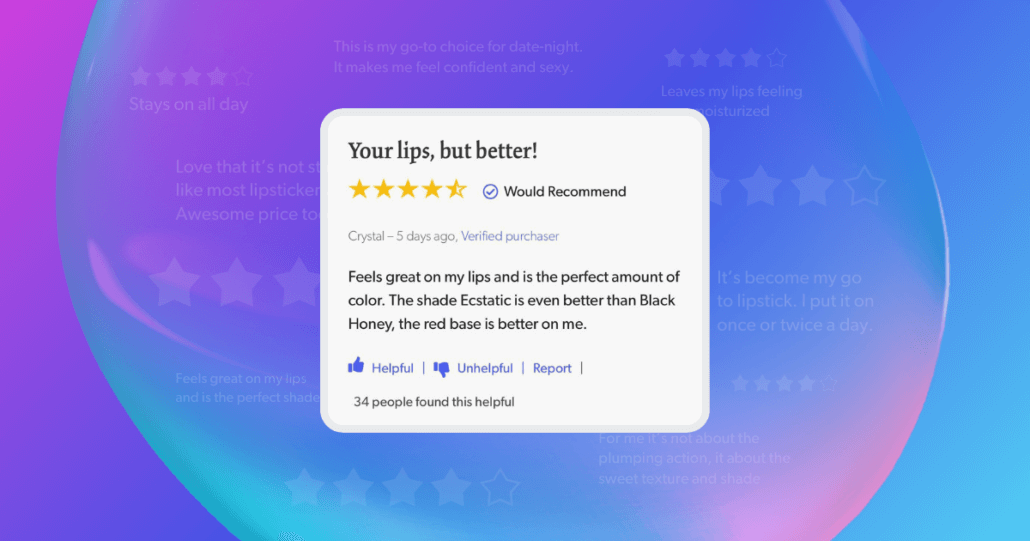January 2, 2024
In today’s consumer-driven world, customer centricity and feedback — through social listening — is paramount. When you prioritize understanding your customers and their needs, you earn their trust and exceed their expectations. Trust turns into loyalty, which leads to recommendations for your brand, which means more customers and sales.
That all sounds great, but how can you possibly know what each of your current or potential customers thinks and wants? The short answer is you just need to listen to them in the spaces where you coexist — your social media channels. Social listening is the launchpad to providing value for your customers, and how you respond will determine your success.
Learn how to listen, what to listen for, the best social listening tools, and what to do with the insights from those customer conversations in our social listening guide.
Chapters:
- What is social listening?
- Why is social listening important?
- What to listen for and how to respond
- How to set up a social listening strategy
- Social listening examples in action
- Manage and streamline social listening with Insights and Reports
What is social listening?
Social listening is all about actively tracking and analyzing the online conversations that matter most to your brand. Whether it’s your customers, competitors, or industry buzz, social listening tunes into these discussions across social media platforms. The goal? To glean insights into customer sentiment, preferences, and emerging trends, and to pinpoint any pain points or problems that need addressing.
Social listening goes beyond keeping your digital ear to the ground. It’s about diving deep into the data you collect from social media conversations and analyzing it to understand public perception. This involves interpreting the data to uncover patterns, sentiments, and trends. By doing so, you can anticipate market shifts, innovate in response to customer feedback, and develop targeted digital marketing campaigns.
Take, for instance, a beauty brand that uses social listening to track discussions around skincare routines.
They notice a growing trend in conversations about natural ingredients and eco-friendly packaging. By aligning their product development and marketing strategies with these insights, the brand successfully launches a new line of eco-friendly skincare products. The result is a product line that resonates well with their target audience, leading to increased brand loyalty and sales.
Social listening vs. social monitoring
Social monitoring is another marketing tactic related to social listening, but the two are not the same. On the one side, social media monitoring is more targeted, with the goal of directly and immediately responding to a specific occurrence, like a brand mention or customer service question or issue. Whereas social listening is more comprehensive and aims to extract insights from social discussions to inform and shape your overall brand strategy.
Employing both social listening and brand monitoring allows brands to be reactive in customer engagement and proactive in strategic planning. Let’s run with the beauty brand example. While they used social listening to uncover an emerging trend and reshape their broader brand strategy, they might simultaneously use social monitoring to quickly address a customer’s complaint about a delayed shipment, and enhance customer satisfaction.
Why is social listening important?
Social listening allows you to understand the key factors that affect your company’s success. It helps you become an invaluable presence in your customers’ lives and a force to be reckoned with in the eyes of competitors.
Understand customer preferences
Understanding the preferences of your customers is crucial for delivering products and services that attract and retain them. Through social listening, you can discover what particular features or qualities they love about individual products, your brand presence, and services like customer support, sustainability, and delivery.
Customer preferences can be about your brand specifically, product categories, or your industry as a whole. By actively listening to and analyzing social media conversations, you gain the ability to pinpoint specific likes and dislikes. This process enables you to fine-tune your offerings, ensuring they hit the mark with your target audience.
Address customer dissatisfaction
Customers might not always have a great experience with your brand or products, and that’s okay — addressing customer dissatisfaction is always an opportunity for growth and improvement. As we mentioned above, from a monitoring standpoint, social media can be a customer service tool to promptly address specific concerns and complaints before they escalate.
At the listening level, you can use these instances to uncover the underlying causes of customer dissatisfaction and gain valuable insights into common issues within your industry.
A clothing brand might discover through social listening that a significant number of consumers are frustrated with the lack of diverse sizing options in online shopping. This insight can prompt them to reevaluate and potentially revamp their sizing options, addressing a widespread customer need, boosting the brand’s reputation, and tapping into a new customer segment. Win-win-win!
Stay ahead of emerging trends
For your brand to stay relevant, it has to be ahead of trends. Social listening essentially serves as a radar for detecting the latest fads and preferences directly from the consumers, whether it’s must-have styles, music, products, or memes.
Tracking trending topics and hashtags allows you to keep a finger on the pulse of shifts in consumer interests and preferences, so you can adapt your social media marketing, product, and customer service strategies in real-time.
Glean valuable competitor insights
Competition is fierce out there, especially in the world of e-commerce. While the focus should be on your brand, you also need to keep an eye on your competitors, their moves, and customer perceptions about their products, marketing, and customer service.
Social listening helps you understand the competitive landscape, identifying both the strengths and weaknesses of your rivals, so you can uncover opportunities to outperform in areas where they fall short. It’s essentially an opportunity to capitalize on their missteps by enhancing your own products or messaging in ways that directly address the gaps left by your competitors.
Find unique collaboration opportunities
Social listening is instrumental in finding potential influencers, UGC creators, complementary brands, and industry or subject matter experts to partner with.
These individuals and companies are often at the forefront of trends and discussions, making them ideal partners for collaborative campaigns. When reviewing the mentions, hashtags, and keywords you track, you can find active and trusted voices contributing to those conversations.
Teaming up with them on campaigns introduces your brand to new audiences in a way that feels organic. It also aligns your brand with a voice that your target audience already knows and respects. Partnerships with the right creators and brands can cut through the noise, offering the kind of authentic content that builds trust with consumers.
Enhance brand reputation and crisis management
For all the benefits social media has, it also puts businesses in a vulnerable position. A single misinterpreted tweet can go viral and break a brand’s reputation in a split second. Keeping tabs on what’s being said helps you safeguard the brand’s image and address any potential issues that could evolve into a full-blown crisis — in such cases, a rapid response can be the difference between a minor hiccup and a major PR disaster.
Social listening serves as an early warning system, allowing you to detect and respond to negative publicity or emerging issues promptly, and remain in tune with your audience’s perceptions and expectations.
Improve your content strategy and marketing campaigns
Social listening takes the guesswork out of what your audience is talking about, feeling, and expecting. Using these insights, you can draw inspiration to craft content that not only aligns with but also anticipates current audience interests, leading to more effective marketing efforts.
When your content is relevant to the audience, it naturally leads to higher engagement and conversion rates, turning those casual browsers into paying customers.
Consider a travel agency that uses social listening to gauge the mood and preferences of its audience. They notice a growing interest in domestic travel and seize the opportunity to tailor their Google ads campaigns to focus on local tourism.
This strategic pivot results in a campaign that resonates with the audience’s current desires, leading to increased bookings and a chunkier bottom line.
What to listen for and how to respond
There’s numerous conversations about your brand, products, industry, and competitors happening on social media, so focusing on everything isn’t feasible or efficient. These key areas of discussion are a good place to start if you want to reap the benefits of social listening.
Topics of interest
Monitor trending hashtags and popular content to align your marketing with your audience’s current interests. Pay attention to current events, big cultural moments, or trending hobbies that can shape your social media presence and interactions.
How to respond: Actively participate in conversations related to the major interests of your audience. Respond to their content or create your own that repurposes relevant content you already have, shares your brand’s perspective, and connects your products to popular use cases.
which side are you on? 👀 pic.twitter.com/Q71DeZLoOj
— Swiggy (@Swiggy) July 21, 2023
Invite your audience to share their thoughts — this not only positions your brand as a thought leader but also fosters community engagement.
Personal challenges and goals
Social media is a space where people often share personal challenges and aspirations. Social listening allows businesses to tap into these conversations, gaining insights into the real-life experiences of their audience. Access to these details enables you to offer solutions, support, and products that genuinely help customers.
How to respond: Craft campaigns and messaging that highlight how your products or services can address your customers’ needs or make progress toward their goals.
Common issues and questions about products and services
Customers frequently turn to social media to seek information and voice their questions about products and services. Identify these common questions that come up when customers tag your brand or use your branded hashtags. This allows you to not only resolve issues quickly but also create permanent solutions and resources to improve the customer experience.
How to respond: Compile and maintain a list of the common questions that arise and use those to create online resources. For example, you can include them in a Questions and Answers section on your product pages, optimize product details with pertinent info, create a Frequently Asked Questions (FAQs) website section, and create social media content that addresses FAQs.
Need a hand? We’re here to help! @/📩
— Adobe Care (@AdobeCare) December 9, 2022
-Check out the official Help Center 👉 https://t.co/R0nr73NoV4
-Visit our Community Forums page for more discussions ➡️ https://t.co/f8Ncnj9Hsk
-For our Server Status & more → https://t.co/ILcKyJd79n
This is also valuable information to share with your customer service team and integrate into your live chat technology to prepare answers for these common questions.
Discussions about competitors
Social listening is a nifty tool for competitor research. Follow conversations that mention or tag your main competitors to find out what customers love or dislike about them.
For example, you might discover sales and promotions, packaging, product details, subscription services, or something else that either works well or isn’t doing the trick. Then, you can use that information to do it better or step up your game in areas where they’re beating you out.
How to respond: Share the insights you’ve collected about your competitors with the broader marketing, sales, and product teams. Make improvements to products, services, and marketing where needed, and highlight areas where you outshine competitors in your marketing and social media content.
Brand advocates and network partners
Pay attention to the customers who rave about your products and share content about your brand. These brand advocates are the customers who showcase your products in their everyday lives. You can also keep track of other like-minded businesses with products that would interest your audience.
How to respond: Develop relationships with creators and brands that might make good partners in the future. When someone posts quality content about your brand or industry, share it on your own social networks. Initiate deeper partnerships by reaching out to customers or influencers directly to be brand ambassadors.
Likewise, reach out to other brands to co-host a giveaway or collaborate on product packages.
Product mentions
Track conversations that call out your specific products and categorize them based on positive and negative feedback.
How to respond: Evaluate the feedback about your products and identify any patterns that come up. For example, you might discover multiple complaints about certain products but rave reviews about others. Share this information with your product team so they can identify how to improve products or build upon successful ones.
How to set up a social listening strategy
Social listening is like a mind-reading superpower. While monitoring certain areas of interest ad hoc is helpful, executing an intentional social listening strategy can yield far more impactful results for your brand.
1. Define your social listening goals
Start by pinpointing what you want to achieve through social listening, be it understanding customer preferences, identifying pain points, or keeping a pulse on brand awareness.
Make sure these objectives are specific, measurable, and, most importantly, align with your broader business goals. The latter ensures that every piece of data collected and every insight gleaned serves a larger purpose and drives the brand forward.
Establish key performance indicators (KPIs) related to your social listening goals. These could include metrics like engagement rate, sentiment analysis results, the volume of brand mentions, or specific hashtag performance. Regularly tracking these KPIs will provide you with quantifiable data to evaluate the success of your social listening efforts.
2. Choose the right social media listening tools
From sentiment analysis and trend tracking to influencer identification, social listening tools are designed to cater to different business sizes and needs. The key is to find a tool that not only aligns with your specific social listening goals but also integrates with your existing marketing strategies.
For small e-commerce businesses, the focus might be on cost-effective tools that offer essential listening features. These tools should be user-friendly and capable of providing insights into brand mentions, customer sentiment, and emerging trends.
On the other hand, larger businesses might require robust platforms that offer advanced analytics, CRM integration, and data analysis capabilities. These social listening tools can handle larger volumes of data and provide deeper insights, which are key for big businesses with a wider audience reach.
3. Identify keywords and topics
This step is crucial, as it determines the scope and relevance of the insights you’ll gather. First, identify the core aspects of your brand and industry (these can range from specific product names to broader industry terms). Include variations and common misspellings to ensure comprehensive coverage.
Depending on your goal, you might expand your keyword list to include competitor brand names and key products. Don’t forget to add buzzwords, industry trends you’re already aware of, and seasonal topics that are likely to generate conversation. For example, if you’re a home decor brand, you might track keywords related to home improvement trends, seasonal decorations, and DIY projects.
To make your tracking more actionable, categorize your keywords into different themes or topics. This categorization can help you segment the data and analyze it more effectively. You might have categories for product feedback, customer service inquiries, and general industry discussion.
Remember, social media is dynamic, and so should your keywords and topics be. Regularly review and update your lists to reflect new products, campaigns, or shifts in industry jargon.
4. Determine your social media listening methods
There are various approaches to social listening and different techniques for finding meaningful conversations. Each method will unveil unique insights, and your choice will depend on the goals you originally set.
Track mentions and hashtags
Use a social media management tool to track mentions of your brand and your competitors, as well as the hashtags you designate. This way, you can access conversations on your different channels in one place.
This is a holistic way to quickly gauge public reaction to new product launches, marketing campaigns, or company news so you can adjust strategies on the fly and ensure that your brand’s messaging aligns with audience expectations and sentiments.
Sentiment analysis
Sentiment analysis measures customers’ perception of your brand and products based on positive and negative feedback and particular opinions expressed. And Sentiment analysis AI tools leverage machine learning that includes natural language processing (NLP) to interpret conversations and determine how people feel about your brand.
This method is particularly effective in identifying areas of customer satisfaction and dissatisfaction, which are crucial for guiding strategic improvements and maintaining a positive brand image.
Trend tracking
Use your social media management tool or the specific channel’s analytics to reveal trending content and topics. For example, the TikTok Creative Center provides robust insights on trending hashtags, creators, songs, and videos over different time periods. Analytics features included in other channels like X (formerly Twitter) reveal high-volume keywords that inform what’s trending as well.
Proactive listening
Initiate the conversation by asking your audience for questions and feedback on your social channels. Leverage engagement features like the Questions Sticker for Instagram Stories or ask your followers to respond to your posts as a comment or a video response on TikTok.
5. Analyze and interpret social listening data
This stage is where the raw data transforms into actionable insights.
Start with quantitative analysis, which involves measuring the volume of mentions, the reach of your hashtags, and the frequency of keywords. Social media analytics platforms use automation to provide you with metrics such as engagement rates, sentiment scores, and trend graphs.
However, quantitative data only tells part of the story. Qualitative analysis is equally important. This involves reading through posts, comments, and conversations to understand the context behind the numbers. Look for recurring themes or sentiments in the discussions about your brand. Are customers consistently praising a particular aspect of your product? Are there recurring complaints or suggestions for improvement? This level of detail can provide deeper insights into customer attitudes and perceptions.
6. Review and adapt your social listening strategy
Social media is constantly changing, so what works today might not be as effective tomorrow. Plus, your business priorities also change and your social listening needs along with them. Regularly assessing the performance of your social listening strategy keeps it relevant and effective.
Incorporating feedback loops is also beneficial. Use the insights gained from social listening to make changes in your business, and then monitor social media to see how these changes are received. This approach ensures that your strategy is not just reactive but also proactive in shaping your brand’s presence and offerings.
Social listening examples in action
Social listening isn’t an exact science. It’s a practice that continues to evolve with many different purposes and applications. To better understand how to use the information that’s accessible to you, take a look at these social listening examples for how other professionals have done it with impactful results.
Petco’s branding and services evolution
Petco considers social media and search the “largest focus groups on the planet” and relies on signals and feedback from social to evolve their offerings. For example, during the early days of the COVID-19 pandemic, they expedited a curbside delivery program based on listening to their audience’s preferences on social.
In addition to offering new services informed by social listening, Petco shifted their focus to be a pet health and wellness company based on the priorities of their audience. Another way Petco leverages feedback and data is by answering customer questions on their website with Questions and Answers.
This feature provides a helpful resource on relevant product pages for customers who want to learn how specific products meet the unique needs of their pets.
Nestlé Canada’s product improvements
By listening to and acting on their customers’ feedback, Nestlé Canada saved a struggling product and returned it to its former glory. The major food brand ruffled some feathers when they modified the recipe for a favorite iced tea product. Within a month of releasing the new version, customers made their complaints known on Nestle’s marketing channels and in product reviews. As a result, their sales and review ratings dropped.
These insights led to action, and Nestlé responded to the negative sentiment by reinstating the original recipe. By finding and implementing customer feedback, they restored high customer satisfaction and raised their average customer rating for the product from 1.7 to 4 stars.
Taylor Swift’s “All Too Well” (10-minute version)
Taylor Swift is not only one of the biggest pop stars of our time but also something of a marketing genius. Social listening is definitely part of her strategy to win over fans time and time again. One example is how the 10-minute version of the fan-favorite song “All Too Well” from her album Red came about.
After hearing reports of a 10-minute version of the song, fans took to social media to call for its release. Taylor heard these messages and ultimately decided to record and release the complete version on “Red (Taylor’s Version)” along with a music video, which won a Grammy for Best Music Video. This is a great example of Taylor listening to her audience’s requests and responding with a new product release or, in this case, a song.
Manage and streamline social listening with analytics
Social media teams can only do so much when it comes to conducting social listening. Small teams, multiple channels to review for social conversations, and manual processes limit what’s possible. That’s why automated tools are invaluable for managing and synthesizing large amounts of data.
Bazaarvoice’s Social Analytics tools measure your performance for social media efforts, influencer marketing, and revenue reporting all in a single dashboard. Check out the full capabilities here. Or get in touch below to learn more.
Get started








